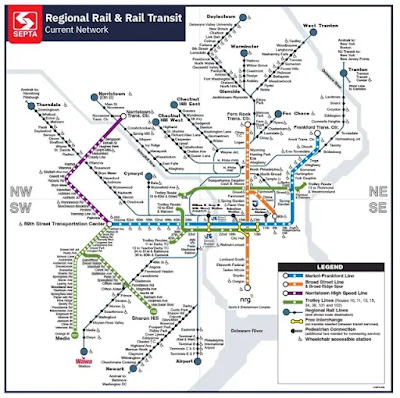Impact of proposed transit cuts at SEPTA/Philadelphia presented in graphically compelling ways
With WFH and the ending of special grant programs from the Biden Administration ("Public transit agencies eye service cuts as pandemic aid runs out," Marketplace/NPR), coupled with the Trump Administration's pro-car bias, virtually every transit agency is facing financial exigency in future budget cycles ("Metra, CTA and Pace warn of possible 40% service cuts starting in 2027," NBC Chicago, "What to know about possible PRT cuts and how to make your voice heard," Pittsburgh Post-Gazette) , often with pleas like in Philadelphia ("No more excuses — Harrisburg Republicans must find a way to fully fund SEPTA," Philadelphia Inquirer) and the SF Bay, for state bailouts.
Process for considering transit service cuts in Pittsburgh
WFH has totally messed up transit agency budgets, shifting the most use from morning and evening commute to primary business districts, to use spread out during the day, across the system, further increasing costs alongside revenue decreases. DC for example has lost about 250,000 train riders from pre-covid highs.
The Reddit Philadelphia has included entries on what budget cuts would to do to SEPTA's, the regional transit agency for Philadelphia, service network, and I thought they've had some good graphics to illustrate the changes.
-- SEPTA budget cut fact sheet
SEPTA is facing a $213 million annual structural deficit due in part to pandemic-related ridership reductions and inflationary pressure on labor and materials costs. (Fare evasion doesn’t help matters, costing from $30 million to $68 million yearly, according to SEPTA projections.)
The transit agency released a $1.65 million operating budget on April 10 that included a doomsday scenario of service cuts, along with an average fare increase of 21.5% across the board. In all, up to 55 bus routes would be eliminated, five Regional Rail lines shut down, and 66 stations closed. Other routes and lines would see reduced frequency of buses and trains.
Those cuts would occur in two phases, this fall and on Jan. 1, without new state subsidies, the transit agency says. If the full menu were enacted, all rail services would stop at 9 p.m. across the SEPTA network early next year.
-- "PL #7: Using the Purple Line to rebrand Montgomery and Prince George's Counties as Design Forward," (2017)
-- "Design as city branding: transit edition," (2012)
-- "City (and university) branding: brand deposits; brand withdrawals; brand destruction," (2012)
-- "Georgetown: A subtle but important difference between branding and identity-positioning," (2010)
-- "Identity ≠ branding or Authenticity is the basis of identity," (2007)
-- "The taxi livery debacle as a lead in to a broader discussion of the importance of "design" to DC's "brand promise," (2012)
-- "Illustration of government and design thinking: Boston's City Hall to Go truck," (2013)
-- "(DC) Neighborhoods and commercial districts as brands," (2012)
Labels: design method, graphic design, information design, provision of public services, transit funding, transit marketing, urban design/placemaking, urban revitalization











0 Comments:
Post a Comment
<< Home